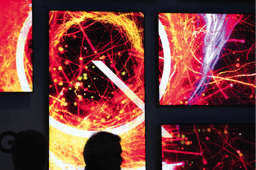People, Spaces, and Technology: The New Balance of Work

After several years of remote work, I recently had the satisfaction of returning to the office. While technology makes interaction possible, it can’t fully replace the richness of the relationships built through in-person collaboration. Strengthening teamwork, organizational culture, and employee wellbeing is key to the future of any organization. But how can we deliver a positive experience in a hybrid work model?
As hybrid work becomes the norm, office attendance has grown increasingly unpredictable. Many employees feel frustrated when they arrive at the office only to find absent colleagues, unsuitable spaces, or available tools that don’t support their tasks. Today, offering the right spaces is no longer enough: it's about enabling meaningful interactions, smooth coordination, and informed decision-making.
The Power of Data-Driven Work Environments

A recent report by Worktech Academy in collaboration with Modo highlights how data is transforming the workplace experience. No longer limited to tracking occupancy, data now powers workforce planning, space optimization, and experience design strategies. Thanks to AI and machine learning, we’ve moved from observing patterns to generating predictive and prescriptive insights.
One emerging approach is journey mapping, often used in customer experience research, to understand how employees move, interact, and work throughout the office. This allows organizations to identify friction points and tailor environments to better meet employee needs.
Control devices are key to building intuitive and adaptable workplaces. Integrated booking systems, for example, allow users to reserve rooms based on availability, capacity, or equipment, directly from the tools they use every day. In addition, platforms that monitor room usage and environmental conditions, such as temperature, noise levels, and air quality, provide valuable data to improve both comfort and operational efficiency. These systems don’t just simplify day-to-day experiences, they enable more informed decisions aligned with employee needs and business goals.
AI for More Inclusive, Safe, and Sustainable Workplaces
AI is not only optimizing workflows, it’s also improving inclusion, safety, and sustainability. By enabling accessible design features and personalized support, it helps create more equitable environments. AI can also track usage patterns to ensure safe occupancy levels and recommend energy-saving configurations, aligning with broader sustainability goals. In this way, it becomes a powerful ally in building ethical, people-centered workplaces.
Key Trends Shaping the Future
- Workplace apps: streamline daily operations, enhance collaboration, and personalize employee experiences.
- Experience re-evaluation: leverage feedback, support tickets, and surveys to redesign spaces around real employee needs.
- Data to design: leverage data to redistribute teams and resources across the workplace for better collaboration and energy.
- Return on Experience (ROX): Test and evaluate experience-led strategies to ensure they align with organizational goals.
Conclusion
A data-driven approach to workplace strategy is no longer optional, it’s essential. As hybrid models continue to evolve, the ability to understand and respond to real employee behaviors and needs will be key to success. By combining smart devices, artificial intelligence, and experience-led design, organizations can create adaptive, inspiring environments that genuinely support their people.
What technologies have you implemented in your projects that made a difference in the workplace experience?
-
Xchange Advocates are recognized AV/IT industry thought leaders and influencers. We invite you to connect with them and follow their activity across the community as they offer valuable insights and expertise while advocating for and building awareness of the AV industry.






Please sign in or register for FREE
If you are a registered user on AVIXA Xchange, please sign in
Couldn't agree more Virginia! But the approach to doing so is still fragmented. Microsoft Places is perhaps the Gorilla in this early game, though still has a lot of maturing to do. There are certainly "Smart Building" players who have been in the game for a while, but have tended to approach things from an RE&F realm. There are room and desk booking players, but they lack depth. I think there is a huge white space right now to actually implementing data metrics that go beyond simple" occupancy" and into measuring impact and outcome of enterprise scale Modern Workplace strategies for companies. Are there any platforms you think are leading here?
Hi @Byron Tarry, thank you for your comment! I completely agree, there’s still a long way to go, but I’m optimistic. While fragmentation is a challenge, we’re seeing promising innovations that, when integrated, can lead to meaningful outcomes. Platforms like VergeSense are starting to unify and analyze data in interesting ways.
Are there any other platforms you’ve seen that support native integrations and open APIs for cross-system data analysis?
https://kodelabs.com/ have an interesting platform around comprehensive "Smart" building management.
https://spaceti.com/ is another up and coming one that caught my eye at ISE. They have built an AI engine focused on:
- Simplified data interpretation
- Actionable advice
- Real-time assistance
- Proactive problem solving
I like that Logitech has entered the game at scale with their SPOT sensor, like Microsoft entering, with Places, and Cisco with Spaces, we need to get beyond all these small "startup" software platform and sensor players that just can't fully tackle the scale and breadth/depth of the opportunity. And I love that all three of them are seeing that Collaboration technologies are so integrally linked given the core to the very existence of the enterprise workplace now is collaboration.
In my discussions with some of the "Smart Building" world, they are often amazed that the AV/UC collaboration industry hasn't stepped more into this world given the inherent natural skillsets and market position we have.
Thanks for sharing this, @Byron Tarry! Really interesting insights — I’m especially curious about how AI-powered platforms and collaboration technologies will evolve in the coming year. I’m looking forward to what InfoComm 2025 might bring in this space.
Balanced, as all things should be!